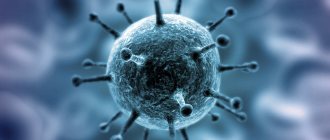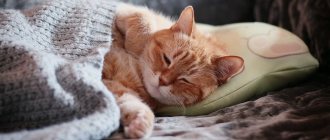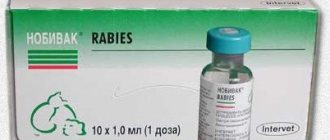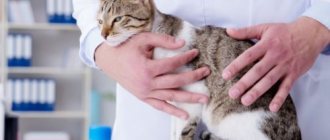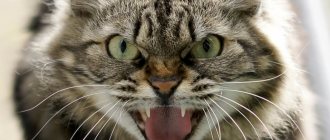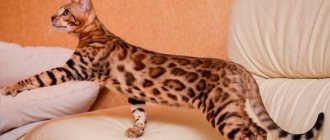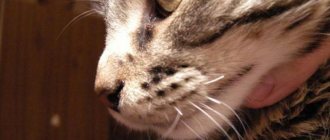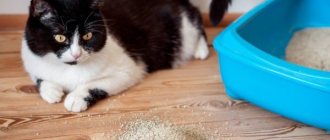Research shows that animals can become infected with the COVID-19 coronavirus, and the severity of the manifestations depends on the type of pet. Dogs get sick from coronavirus easily; the disease can often only be diagnosed through laboratory testing. Cats are more sensitive to the virus - they may sneeze, develop snot, fever, and diarrhea. Therefore, it is important to know what the symptoms of COVID-19 look like in pets in order to provide timely help and not become infected yourself.
What is coronavirus in animals?
COVID-19 belongs to the group of infectious diseases. It infects humans and animals through airborne droplets, as well as through blood and feces. The name is associated with the structure of the virus, on the body of which there are spikes resembling the solar corona.
Coronaviruses can infect animals and cause harm in different ways:
- Coronavirus enteritis (Canine coronavirus) is dangerous for dogs, which affects the small intestine and causes serious disorders. If your pet is infected with canine parvovirus, it may die.
- Cats are affected by Feline coronavirus. It disrupts intestinal function or causes peritonitis (inflammation of the peritoneum). Pathology (primarily peritonitis) is one of the main causes of mortality in cats.
Both diseases are transmitted by the fecal-oral route and are life-threatening, so animals must be vaccinated.
COVID-19 affects the upper respiratory tract. Animals tolerate the disease well. Pets with weakened immune systems and chronic diseases mostly suffer. Coronavirus in animals and humans primarily affects the lungs and kidneys, and intestinal disorders are observed. Pathology can cause serious complications to the diseased organ.
Prevention
In the fight against the disease, it is much more effective to take preventive measures:
- quarantine for at least 3 months for new animals or cats that show any symptoms of the disease;
- Isolate animals that test positive for 12 weeks;
- interrupting contact of kittens with the carrier mother until four weeks of age;
- delineation of places for feeding and toilet, regular hygienic treatment of bowls and tray;
- You can get a new pet after the death of an old one from infectious peritonitis no earlier than two months, provided that the premises are completely disinfected;
- prevention of stressful situations, crowded keeping of animals, in which viral enteritis is transformed into a more complex form;
- high-quality nutrition, daily intake of vitamins;
- increasing immunity with the help of infusions of nettle, rose hips, and medications;
- timely deworming, vaccination and parasite control;
- testing for coronavirus even with minimal symptoms of the disease;
- Regular examination by a veterinarian.
Coronavirus infection is a deadly contagious disease for pets, for which there is currently no cure. The course of the disease in a cat in a milder form does not guarantee that the virus will not mutate as a result of unfavorable factors, and the animal will not develop viral peritonitis. There is a special vaccine for a less dangerous strain of the disease, but it is often ineffective, so it is more important to take preventive measures.
Do cats get COVID-19?
Can a cat get infected with coronavirus? The answer is yes, and the risk is much higher than in a dog. Animals become infected with coronavirus from people, but the likelihood that they infect humans is extremely low. In addition, pets are capable of spreading the disease among members of their species, but on a small scale.
To determine whether coronavirus is transmitted to cats, an experiment was conducted. Infected pets were placed in a cage next to uninfected animals. After some time, some of the cats fell ill. Because the distance between the animals was too close, scientists were unable to determine how the coronavirus was transmitted in cats—by fecal or airborne transmission.
Symptoms and signs of coronavirus infection
(for any of them, it is recommended to get tested)
• Unstable stool not associated with changes in food, poisoning or other external factors. Quite often - blood and mucus in the stool. • Poor appetite, vomiting, lethargy, drowsiness. • Sudden changes in temperature: the animal sometimes has a fever, and sometimes it does not outwardly show concern - only the temperature gives away the virus. • Nervous symptoms - loss of coordination of movements, unreasonable panic, hiding from the light. • Uveitis, keratitis, germination of blood vessels in the eyeball. • Reddened gums. • Low cellular immunity, in particular - bacterial and fungal diseases caused by opportunistic microflora (“skin gets dirty”). • Blood biochemistry differs little from the norm, most often “something is wrong” with the liver and / or kidneys, but in a general blood test, critical indicators are high ESR, elevated lymphocytes (but not necessarily) and low a:g ratio (albumin -globulin proportion), which is a characteristic of cellular immunity. Normally a:g is within 0.75-1.1. • Ascites - a sharp increase in the abdomen with increasing emaciation of the body due to the release of fluid (effusion) into the abdominal cavity.
Coronavirus in other pets
Can other animals get infected with COVID-19? The answer is not always positive. Research has shown the following results:
- Mice, pigs, chickens and ducks do not become infected and do not spread the infection.
- Lions and tigers can become infected from a sick person, but they do not transmit the disease themselves.
- Ferrets and Syrian hamsters can become infected and pass the virus on to members of their own species.
Mink disease is difficult to tolerate - pronounced respiratory symptoms, and the mortality rate is high. Animals get sick with coronavirus and can infect humans. This caused the destruction of mink farms in Spain and the Netherlands, where sick individuals were found. More than 50 thousand animals died.
Tests for coronavirus infection
The presence of a virus in the body can generally be established in two ways - by determining a laboratory reaction characteristic of this particular virus to the genetic material of this virus, or the presence of a virus in the body can also be confirmed by the presence in the animal’s blood of special antibodies produced by the infected organism specifically for this particular virus. But the analysis does not always accurately reflect the picture of the disease. The absence of antibodies can be explained not by the absence of the virus, but by the extreme weakening of the immune system, which is no longer capable of protecting the body in the form of producing antibodies. At later stages of the disease, the virus passes from the intestine into the bloodstream, which may result in a negative test for the virus (rectal smear). These points should be taken into account when making a diagnosis. In Moscow, to check your animal for coronavirus infection, you can contact the Center for Molecular Diagnostics
on Zvenigorod highway, to the Chance or Pasteur laboratory.
| Laboratory method | Required material | The test determines |
| Immunofluorescence method | Whole blood, serum, plasma or effusion | Antibodies |
| Reverse PCR | Feces, rectal swabs, effusion, saliva, or blood | Virus |
Tests and diagnostics for coronavirus
If you suspect COVID-19 in your dog or cat, consult your doctor. The main criterion for diagnosis is the presence of the patient among the people with whom the animal lives. They are the main cause of infection in a pet.
Unfortunately, not all veterinary clinics test for coronavirus. Often it is necessary to negotiate with the human laboratory, acting through a veterinarian. He will take blood and send it for analysis, if possible. You can also use tests that are sold in human pharmacies, but the error rate is high.
Diagnosis of feline coronavirus
Coronavirus is quite difficult to diagnose, due to the fact that the vast majority of cats are asymptomatic carriers or shed the virus for a significant period of time.
FCoV is shed in stool, so the most sensitive test is the Coronavirus Infection Test (FCoV Ag) for detecting the virus in feces. Very rarely, coronavirus is released in saliva; as a rule, this occurs at the initial stage of infection.
A single PCR test of feces is not very informative : if a cat excretes the virus from time to time, it may or may not excrete the virus for a short period of time.
The PCR test should be part of a series of studies and is best done in combination with immunofluorescent antibody tests.
There are different opinions about how to reliably establish the fact that coronavirus has been eliminated (that a cat has been freed from infection) - as a rule, it is suggested to perform 5 consecutive fecal tests using the PCR method with an interval of 4 weeks, and get all the results negative.
According to the Swedish Institute of Virology, a cat is considered not to be shedding coronavirus if 4 fecal PCR tests taken one after another with an interval of 7-10 days are negative.
In any case, a cat that does not excrete the virus according to the results of a series of tests is not dangerous to other animals either in keeping or breeding and does not infect other cats through contact, sexual and vertical (through reproduction) routes.
A decrease in antibody titer to <10 also indicates elimination of the virus, but usually a decrease in antibody titer is observed after the cat has stopped shedding the virus.
To establish that a cat is a lifelong carrier of coronavirus, stool test results for FCoV must remain positive for at least eight months.
Treatment of COVID-19 in cats and dogs
There are currently no clear instructions on how to treat COVID-19 in animals. Each veterinarian proceeds from his own experience and the condition of the animal. Treatment of coronavirus in dogs and cats is aimed at eliminating symptoms – fever, diarrhea, vomiting.
When your pet is sick, it is important to follow the recommendations for caring for it.
What to do at home
- Be sure to consult your veterinarian by phone. If your symptoms worsen, tell him right away.
- Allocate a separate area for the sick animal so that it does not communicate with other animals or people.
- Wash your hands immediately after contact with the animal, its bowl, tray, or toys.
- Wear a mask when caring for your pet. Important: pets should not wear masks, they can harm them.
- Disinfect bowls, toys and other pet care items.
- Reduce contact with the animal - hugs, kisses, caresses. Do not sit on its bedding.
- Soft items (towels, blankets, bedding) can be washed and reused. Washing powder and hot water work great against the virus.
- Since coronavirus is rarely transmitted through animals, there is no need to treat your pets with disinfectants, wipe them with special wipes, alcohol, or hydrogen peroxide.
How to walk
- If a cat that constantly walks outside is sick, do not let it out of the house.
- Walk your dog at times when there are few people and other animals on the street.
- Don't take your dog to the park. Walk only near the house. Pets spread the coronavirus within their own species.
- If you have a private yard, do not take your dog outside.
- Don't let your pet off the leash.
- Clean up animal feces, as this is how the coronavirus is transmitted to animals.
- Do not visit clinics or groomers with your pet. There is a risk of infecting other animals.
- Do not go to places where there are a lot of dogs - coronavirus infects animals.
- Do not allow strangers to touch your pet.
Nature of the disease (strain)
The causative agent of coronavirus infection in cats is an RNA virus that is complexly organized. In addition, the virus is very similar to the causative agent of infectious peritonitis. Babies aged 6-12 weeks are most severely ill, while adult animals can “survive” this disease only with enteritis, maintaining a long-term carrier status of the virus. It is worth clarifying that in catteries this disease is one of the most common (40-85% of whiskers are either already sick or have recovered from the disease and still carry the coronavirus).
The source of infection is primarily sick animals (as well as those that have already been ill), which release the pathogen into the external environment with feces and vomit. The transmission factor is objects that come into contact with the source of coronavirus infection (rugs, dishes, toys, combs, etc.). Stray cats are a kind of “storage” of the virus (reservoir), so they can spread the virus wherever they defecate. And owners of pet purrs can bring the virus into the house on their shoes. This is how a completely indoor cat that does not go outside can become infected.
The mortality rate for this disease is low (no more than 5%), but you should not rely on luck; it is better to seek help from a veterinarian in time to avoid complications.
There are 2 strains of the virus:
- feline enteric coronaviruses (FCoVs), which cause enteritis;
- highly pathogenic – feline infectious peritonitis virus (FIPV).
The intestinal form of coronavirus is easily and almost safely tolerated by a cat.
In four cases out of five, pets become infected with it. The disease usually affects the lining cells of the cat's small intestine and causes diarrhea. The dangerous consequences are that she can become a carrier of the disease, and therefore is doomed to loneliness.
The viruses are very similar in antigenic composition. The second strain is a modified form of the first. The virus mutates and worsens in the body of the animal carrier due to stressful situations. Infectious peritonitis is accompanied by an extremely serious condition and usually ends in death.
The virus attacks white blood cells (macrophages), destroying them, which leads to further infection of tissues and organ systems.
Despite the fact that both diseases are caused by the same pathogen, they manifest themselves in completely different ways, and there are fundamental differences between them. For example, a cat infected with intestinal coronavirus may never experience an acute form of the disease; and the feces of an animal with FIP usually do not contain the dangerous virus.
Therefore, coronavirus infection detected in a domestic cat is not a reason to assume further infection of its body with infectious peritonitis: it can develop in no more than 10% of cases.
Coronavirus prevention
To protect your pets from coronavirus, do not allow them to interact with other people. Do not allow petting, kissing, etc. Limit contact with other animals, keep homeless people away. Avoid places where there are a lot of people and dogs. Watch where your pet steps, go around the grub.
To improve health, give the animal drugs that enhance immunity. Elvita-Udivit has proven itself well - an immunomodulatory drug that relieves inflammation, suppresses viruses and bacteria, and promotes cell regeneration.
Treatment of coronavirus
There is no single treatment regimen for coronavirus. Therefore, treatment most often consists of two main components:
- supporting the body in the fight against the virus;
- symptomatic therapy.
Polyferrin-A or Roncoleukin can be prescribed as antiviral drugs effective against coronavirus. But simultaneously with these drugs, antibacterial agents can also be prescribed:
- Tylosin (tylosin tartrate);
- Penicillin;
- Amoxicillin (Amoxycillin);
- Amoxiclav (Amoksiklav);
- Lemomycetin, etc.
Photo gallery: antibacterial drugs
Amoxicillin in the form of a solution or tablets can be purchased at any pet pharmacy.
Levomycetin should not be used simultaneously with penicillin antibiotics
Penicillin is one of the most famous antibiotics in the world.
Any antibiotic can be purchased in several forms (tablets, powder for preparing a solution, etc.)
Analogues of Amoxiclav are preparations with amoxicillin (Panklav, Noroclav, etc.)
If fluid accumulates in the cat's chest or abdomen, it is removed (puncture). There are owners who simply do not give their cat water, but this cannot be done. The animal should drink as much as it wants. And excess fluid is removed with the help of diuretics:
- Hexamethylenetetramine (hexamethylenetetramine);
- Kotervin;
- Lasix;
- Furosemide;
- Indapamide (Indapamidum).
Photo gallery: diuretics for coronavirus
Kotervin is designed for the treatment of urological diseases in cats, but it has a fairly mild effect on sick animals and has a diuretic effect
In fact, Lasix is an analogue of furosemide, but the price of Lasix is slightly higher
Hexamine is sold in 20 ml bottles, so you can buy it individually (one bottle costs about 50 rubles)
Analogues of Indapamide: Ravel, Indap, Arifon, etc.
You can find Furosemide even in a simple human pharmacy; it is available without a prescription
For vomiting and diarrhea, the cat is prescribed sorbents (for example, activated carbon) and antiemetic drugs:
- Metoclopramide;
- Prochlorpromazine, etc.
Since the tablets can be spat out by the cat, the drug is usually administered subcutaneously. In addition, to avoid dehydration, a sick cat must be supported with blood substitutes, saline agents and other solutions that will be prescribed by a veterinarian. Such drugs are administered by drip. The most commonly used:
- glucose solution;
- saline;
- Ringer-Locke solution, etc.
If intravenous drip infusions must be carried out for several days in a row, then a small device is sewn into the cat’s limb during the first dropper (so as not to search for a vein every time and not torment the animal). After the infusion, the injection site is bandaged so that the cat cannot pull it all out. The next day, all that remains is to unbandage the selected area and connect the system. It's convenient and painless.
Maintenance solutions are inexpensive and are sold at any pharmacy
In addition, the pet will need to be supported with vitamins and special complexes. B vitamins (B1, B12, B6 and B5) and ascorbic acid are usually prescribed. Veterinarians also often prescribe immunocorrective drugs:
- Immunoglobulin;
- Feliferon;
- Fosprenil;
- Gamavit;
- Maxidin.
Immunomodulators are also recommended to be administered by injection. Firstly, it will be much more effective, and secondly, the intestinal mucosa will still not accept the medicine well. And when administered, for example, intravenously, the gastrointestinal tract can be avoided.
It is more effective to administer Gamavit intravenously or subcutaneously, at a dose of 0.1 to 0.5 ml per 1 kg of animal body weight
Yulia Gennadievna Toryanik, forum user, veterinarian
https://www.zoovet.ru/forum/?tid=7http:&tem=1064615
Photo gallery: immunomodulators
Whatever immunomodulator you choose, it should be agreed with your veterinarian
When purchasing a medicine, be sure to read the instructions for use
Some immunomodulators have contraindications for use (for example, the age of the animal)
It is better to buy the product at a trusted pharmacy (so as not to run into a fake)
Before going to a veterinary pharmacy, read reviews about the chosen drug
Immediately after the vomiting has passed, feeding the animal must be restored. The cat must have the strength to fight the virus. The food should be high-calorie, but dietary. The animal is not allowed to eat anything fatty. If your cat eats store-bought food, then part of the problem will go away on its own. As a rule, industrial food is already nutritious and dietary (you can choose a more suitable food from the same line). But if the animal eats only natural food, then let it be light but nutritious food:
- chicken bouillon;
- liquid porridge (rice or oatmeal);
- kefir, fermented baked milk, cottage cheese, etc.
The use of antibiotics leads to the destruction of not only pathogenic microbes, but also the “beneficial” intestinal microflora. Therefore, in order for the body to begin to absorb nutrients from food, probiotic preparations are needed. Probiotics populate the intestines with microflora, but the duration of their use is determined by the veterinarian. The following probiotics are commonly prescribed:
- Bifitrilak;
- Fortiflora;
- Enterol;
- Zoonorm;
- Subtilis, etc.
Photo gallery: probiotics for coronavirus
Bifitrilak contains not only prebiotics and probiotics, but also sorbents
Many probiotics can be bought at a regular veterinary pharmacy, while others will have to be ordered
Probiotics manufactured in Russia tend to be cheaper
The probiotic Fortiflora is available, so you can buy this product in a specialized store
Some probiotics (for example, Enterol) are used to treat both humans and animals
A veterinarian I know told me that probiotics are used throughout the entire antibacterial course. In some cases, antibiotics are no longer used, but lactobacilli still have to be given, since the natural microflora suffers more than other organs. If the coronavirus has progressed from a chronic form to infectious peritonitis, then the intestines are a kind of battlefield between the virus and antibiotics. However, he warned me that if you self-medicate and overuse probiotics, your cat’s body may get used to them. And this is an even more serious problem.
After treatment for enteritis or peritonitis, the cat owner should avoid raw fish, vegetables and foods that are prohibited even for healthy cats. The intestinal mucosa remains vulnerable for some time after an illness, so fiber, bones and other rough ingredients can injure it.
Veterinarians believe that the chronic form of coronavirus does not need to be treated, since medications can “plant” the liver, and the virus will not go away from the body. Intervention during a viral illness is only necessary in cases where the virus has mutated to FIP or caused enteritis.
Do kittens get sick and how are they treated?
Kittens are virus carriers even more often than adult cats. In addition to all other ways of infection, babies can also become infected from their mother. In addition, the kitten’s immune system is not yet fully developed. If in a cat’s body the virus simply “sits” for a long time and quietly, then in the kitten’s body it can cause rapid and irreversible processes. Enteritis and peritonitis are the most common diseases that occur in kittens with a crown. Kittens die from coronavirus infection in most cases.
Kittens also get coronavirus
Kittens are treated in the same way as adult cats. There is only one exception - some drugs have age restrictions, so you cannot prescribe and choose a medicine yourself.
There is one rule - do no harm, and I try to follow it. I'm not saying that a cat with bloody diarrhea shouldn't have been treated. I'm talking about a clinically healthy kitten who is cheerful, cheerful and poops exemplary balls.
Tosya, forum user, infectious disease doctor
https://forum.bolen-kot.net.ru/index.php?showtopic=17144
Treatment of sick cats
If your animal shows signs of infection, take your pet to the vet as soon as possible. He will select treatment based on test results, severity of symptoms, and the presence of other diseases. Symptoms and treatment are closely related. Most of the drugs included in the treatment regimen do not suppress the virus, but eliminate the symptoms of the disease. The duration of treatment is determined by the doctor.
Do not choose medications yourself. There is no single treatment regimen for coronavirus in cats. You may harm the animal rather than help it heal.
Antiviral drugs
When treating coronavirus, general antiviral drugs are prescribed. The drugs prescribed by the doctor include Roncoleukin, Immunal, Viferon.
Antibiotics
Against the background of infection, bacterial infections (chlamydia, toxoplasmosis, etc.) may develop. To stop the development of a bacterial infection, doctors prescribe antibiotics: Amoxiclav, Amoxicillin, Tylosin and other drugs.
Probiotics
Taking antibiotics inhibits intestinal microflora. In parallel with antibiotics, probiotics are prescribed to restore the natural microflora. Drugs in this group include Zoonorm, Bifitrilak, Enterol. Without probiotics, it is impossible to cure enteritis and restore normal digestion.
Diuretics
Diuretic medications are prescribed to remove excess fluid from the body. An infected cat may have fluid accumulate in the lungs or abdomen. The doctor removes the main volume of fluid using a puncture. Diuretics remove excess water from the body. Popular diuretics: Furosemide, Lasix, Hexamine, Indapamide.
A sick cat should not be prohibited from drinking a lot instead of taking diuretics. This will worsen his condition.
Treatment of enteritis
For enteritis, symptomatic treatment is prescribed: sorbents and antiemetic drugs. Since substances are poorly absorbed through the inflamed mucous membranes of the intestines, medications are administered by droppers.
If the body is dehydrated, blood substitutes or saline agents are administered through IVs. The administration of saline solution, Ringer-Locke solution is often prescribed. In case of exhaustion, glucose drips are prescribed.
Immunomodulators
These drugs stimulate the immune system, which helps the body recover faster. Immunomodulators are drugs based on vitamin-mineral complexes. The veterinarian can prescribe Gamavit, Immunoglobulin, Maxidin, Polyferrin-A, Roncoleukin, Glabcan-5.
Sometimes the doctor separately prescribes taking B vitamins and ascorbic acid. Vitamins and drugs to stimulate the immune system are recommended to be administered through droppers. This increases the effectiveness of administration, since the active substances enter directly into the blood.
Symptoms of infection
Animals of any breed can get sick. The first symptom of infection is often diarrhea. It may go away in a week. Sometimes owners do not consider this a reason to contact a veterinarian. They regard diarrhea as a symptom of food poisoning or stress.
Stages of the disease
With the development of a subclinical form of the disease, the animal loses its appetite. Refusal to eat, vomiting and diarrhea are observed. These symptoms may also go away within 1-2 weeks. If the owners do not take action in time, the animal may remain a carrier of the virus. In severe cases, coronavirus enteritis (FECV) or infectious peritonitis (FIPV) develops.
Can viruses mutate in the body? Yes, they can, and this causes the pet’s condition to worsen.
General symptoms
How to identify coronavirus (symptoms of the disease):
- Decreased activity level, drowsiness.
- Refusal to eat or decreased appetite.
- Weight loss, exhaustion.
- Stunted growth in kittens.
- Increase in temperature (norm 38-39C).
- The coat becomes dull, brittle and dry.
- There is an unpleasant odor from the mouth.
- Palpation of the abdomen causes pain (the cat meows and tries to escape).
- Plaque may appear on the tongue and eyelids.
Enteritis and gastroenteritis
Coronavirus gastroenteritis in cats is an inflammation of the stomach and small intestine caused by a virus. A symptom of the disease is diarrhea, which may contain blood and undigested food fragments.
Enteritis is often accompanied by vomiting and bloating. Symptoms characteristic of a cold are less common: nasal discharge, sneezing, coughing. Due to anemia, the mucous membrane of the palate turns pale.
Infectious peritonitis
The main symptom of peritonitis is an increase in abdominal volume. Due to the accumulation of fluid in the abdominal cavity, it becomes rounded. Heart failure and shortness of breath occur, which can progress to pleurisy.
Sometimes dry peritonitis develops, which is accompanied by organ granulomatosis. When an animal's liver is damaged, yellowing of the mucous membranes is observed. If the kidneys fail, urination is impaired. Atony, convulsions, and paralysis of the limbs develop.
Video from a veterinarian about peritonitis
How can an animal become infected?
The owner should know exactly how coronavirus is transmitted in cats in order to protect the pet from infection. The cat family is characterized by 6 modes of transmission of infection (FECV strain):
- Contact with urine or feces.
- Using one bowl.
- Contact with nasal discharge.
- Contact with secretions from sneezing and coughing.
- Transplacental transfer.
- Infection of kittens through milk.
The main route of infection is oral-fecal. Contact for infection can be not only direct. The virus is sometimes transmitted through humans, for example, if the owner does not wash his hands after cleaning the litter box. The FIPV strain is transmitted only through blood.
Video about transmission of the virus to an animal
The incubation period of the virus is 2-3 weeks. A recovered individual sometimes remains infectious for 2-3 months after the symptoms disappear.
All premises where a horde of cats are located are at risk: basements, shelters, dysfunctional apartments of pensioners. If you take a pet from poor conditions, you need to be tested for infection.
Diagnostic tests
One test is not enough to make an accurate diagnosis. Tests for coronavirus are carried out in a complex:
- Stool tests: PCR (polymerase chain reaction), ICA (immunochromatographic analysis).
- Blood tests for antibodies: ICA, ELISA (enzyme-linked immunosorbent assay).
- General clinical analysis and blood biochemistry.
- PCR diagnostics of blood serum.
- Antibody titer. (400-800 suspicion, 800-1600 carrier, from 1600 acute form).
- Testing the sensitivity of microflora to antibiotics.
- Biopsy and tissue histology (complex tests that are not carried out in every clinic).
Any virus test sometimes gives a false positive result. To avoid mistakes when making a diagnosis, you should retake the test 2-3 times. You can do this in several laboratories so as not to doubt the results.
After treatment, coronavirus tests are performed to check the effectiveness of the therapy. Cure is indicated by 3 negative results obtained in a row.
An inexperienced veterinarian may confuse infectious peritonitis with ascites. If the doctor diagnoses “ascites” after examining the animal, insist on a clinical diagnosis. You need to act quickly and not skimp on tests. Otherwise, you may lose your pet.
Can a kitten get sick?
Kittens under 1 year of age and older cats are at risk. In kittens, immunity has not yet been formed, and in old cats, the immune system is weakened. Old age begins after 7-8 years. If your pet is at risk, be more attentive to preventive measures.
Treatment of kittens
When treating kittens, the same schemes are used as for adults. The difference lies in the doses of drugs, which depends on weight. It is recommended that kittens be treated in a hospital because they quickly develop dehydration and other complications.
Forms of the disease
The disease has three forms, which are conventionally divided into wet, dry and hidden. In the first case, the blood vessels of the abdominal cavity and pulmonary pleura are damaged. There is effusion of these organs, that is, exudate (fluid from small blood vessels) accumulates. In kittens, the body temperature rises greatly to 40 ° C, weakness, lack of appetite, diarrhea, and peritonitis occur.
Distemper in cats: symptoms and treatment at home
Note! During pulmonary pleural effusion, kittens begin to wheeze and choke.
Typically, with the wet form of an infectious virus, the animal dies within a week. If this does not happen, then pancreatic dysfunction, as well as renal and pulmonary failure, are added to peritonitis.
More mature cats are susceptible to the dry form of the disease. No fluid effusion is observed. Meanwhile, in cats, motor activity decreases and there is no appetite. Diagnosing this form is quite difficult, since it occurs without visible symptoms. In the future, animals may develop kidney and liver disease, paralysis, convulsions, and paresis. Often, four-legged animals suffer from apathy or, conversely, aggression, as well as eye diseases.
The disease has three forms
In the latent form of the virus, the disease does not manifest itself in any way. Cats become virus carriers for a long time, infecting their own kind without getting sick. Over time, the latent form mutates into either dry or wet, or the disease completely recedes.
Sources of infection and incubation period
Viral diseases in cats: infections, symptoms, treatment
The virus enters the body through the nasopharynx and may not manifest itself for a long time. Meanwhile, sources of infection, according to research, can be:
- dirty, stagnant water;
- poisoning with chemicals or mushrooms;
- eating tubular bones, which can damage the intestinal walls;
- dysbacteriosis;
- changing one type of food to another;
- poor nutrition, violation of a balanced diet;
- the presence of worms that secrete toxic substances;
- low-quality pet food that causes fungal diseases.
There are a huge number of sources of infection
Also, the disease in quadrupeds occurs due to pathologies in the gastrointestinal tract, with ischemia, atherosclerosis and stress.
The incubation period lasts about a week. Coronavirus infection in cats at this stage fully manifests itself.
For your information! It has been observed that the virus can remain in a cat litter box for a long time. After use, it should be burned or tightly packed in a bag and thrown away.
During the incubation period, pets experience general lethargy, lack of appetite, and intestinal upset. Mucus and blood are found in the stool, fluid leaks from the eyes, red gums become pale, and body temperature constantly changes.
Principles of combating coronavirus infection
Since coronavirus is a special virus that is not treated, but eliminated, the basic principles are as follows: 1. Separate (in different rooms) keeping cats during the removal of the virus is used for the following purpose: each cat removes the virus at different times. To avoid re-infection of a cat that has eliminated the virus with a cat that still has corona, cats should be isolated. 2. Disinfection of premises, bowls and trays - used to avoid repeated self-infection. 3. Transfer to natural nutrition. It has been tested repeatedly on a large number of patients - on industrial feeds and even on mixed diets, the elimination of corona significantly slows down or becomes impossible altogether! The main task with coronavirus living in the intestines is to normalize the digestive cycle, strengthen the intestines, make it work to expel the virus. This is unattainable with industrial feed. Firstly, because there are so many enzymes that the cat’s stomach has almost nothing to do, but it has to actually work. Secondly, we need to regenerate damaged intestinal walls, and this task can only be accomplished with meat; only real fiber can become the material that can restore and strengthen the intestines. Feeding raw meat is a prerequisite for eliminating coronavirus. 4. Use of immunomodulators and immunostimulants. At Lena's Haldis Hospital, she tries to use 3 courses of immunomodulators at monthly intervals. This is the well-known Polyferrin-A and Roncoleukin. Canine Globcan-5, which produces antibodies to coronavirus, has proven itself well. Likopid 1 mg, its veterinary analogue Glycopin, turned out to be very effective. In addition to the above, she uses in this series Thymogen, Heel Engystol in tablets, Phytoelita Protection against infections, Neoferon, Immunal, Baksin-vet, Viferon. As general strengthening drugs - Nucleopeptide, PDE, Elvestin, Tsamaks, ASD-2. Naturally, all of the above is applied to patients depending on the general condition and existing symptoms and secondary infection. Those. From the list, what is needed specifically for a given patient is selected. Various combinations are possible, but they are tailored for a specific patient! Immunostimulating drugs help eliminate coronavirus and help treat symptoms and other infections. 5. Treatment of symptoms and secondary infections. In this matter, it is better to be a supporter of homeopathy, try to use herbal preparations and mineral and vitamin supplements to a greater extent. It is mandatory to simultaneously use protective drugs (hepato-, nephro- and pancreatic protectors, pro- and prebiotics) to protect and treat the liver, kidneys, and organs of the digestive system, which are most susceptible to the negative effects of corona. Dosages are selected individually! I also constantly use mineral-vitamin complexes with a predominance of vitamins B and C, containing iron. 6. When removing crowns, it is extremely important to regularly get rid of all parasites that clog the gastrointestinal tract. It is necessary to deworm, as a rule, once every 3 months, but at least once every six months. 7. The use of sorbents is indicated - for temporary deterioration of the condition, for intoxication, for diarrhea, for anthelmintic treatment. First of all, this is Enterosgel, as well as Smecta, Activated carbon (if it is not possible to urgently find Enterosgel and Smecta). 8. Difficulties in eliminating coronavirus are associated with indolent infections such as mycoplasma. Mycoplasma is the most common companion of corona. In addition, corona attracts secondary bacterial and fungal infections. Almost every patient has/or mycoplasma\bacteria (in the eyes, ears, skin, in the gastrointestinal tract - pathogenic and conditionally pathogenic)\yeast-like and other fungi. After mycoplasma, the second frequent companion of corona is chlamydia and calicivirus. Herpesvirus was rarely detected by PCR tests, but respiratory symptoms are very common. Of the protozoa, Toxoplasma is most often found. 9. The albumin-globulin ratio plays an important role in predicting the success of treatment. If it is low (below 0.6-0.7), no matter what causes it (it must be borne in mind that high globulins and low albumin do not necessarily occur only with coronavirus, but, for example, with a number of hepatic-renal diseases), such patients often (but not always!) also take a long time to recover from coronavirus. 10. Tests for coronavirus are taken after 3.5 weeks. after completing the immunomodulator course. Recovery is considered to be the receipt of at least 3 negative results from tests taken at monthly intervals.
Diagnosis of the disease
The main question that pet owners ask their veterinarian is whether coronavirus infection in cats can be treated. In fact, the answer is half yes. The disease must be diagnosed at an early stage. As soon as your cat exhibits symptoms such as vomiting or diarrhea, it should be hospitalized immediately.
There are also three types of stages of the disease
The doctor will order a test to check for infection. To do this, you need to bring animal feces with you. It will identify the disease, which will help the specialist prescribe the correct treatment. In addition, the laboratory will conduct histology and perform tests: they will study feces, blood plasma, prenatal and ascid fluid. Since cats have antibodies that resist the virus, their maximum concentration for peritonitis should be 1280.
The need to fight coronavirus
If there is a positive test for corona, but the cat looks clinically healthy, this does not mean that it really is so. The cat is already UNHEALTHY! The virus will slowly but surely destroy internal organs and negatively affect the health of the organism carrying it within itself. Moreover, positive sires will also have kittens that are positive for crown. And always in the background looms the ominous shadow of viral peritonitis, which grows precisely from the crown, and the theoretical 5-10% of its degeneration for the owner of one particular animal turns into 100 or even 1000 when this misfortune comes to the doorstep. The thought often comes from experienced breeders: “Corona is nonsense, all cats have it, in all nurseries, it’s easy to get infected and easy to get rid of, and if it turns into a pathological form of viral peritonitis and the animal dies, it means its immune system was damaged.” weak, and in this case the disease played the role of natural selection.” Not to mention the cynicism of such a point of view (after all, purebred animals, by definition, are subjected to unnatural selection by humans; it is humans who choose mating partners for the cat, who may be infected; the conditions in the nursery are often not at all conducive to strengthening the health and immunity of the cat), it becomes clear why coronavirus The infection is sweeping through the world of cats on such a colossal scale. “Thank you” to everyone who still thinks so, thanks to this opinion we will never have a high level of cat health. And on the forums, topics will appear again and again - help, FIP, and in response - yes, hang in there, we’re sorry, but this can’t be cured, you’re just unlucky... Coronavirus infection has a detrimental effect on the cat’s immunity . Here's what Lena Haldis says about this. “I think that figuring out what comes first - immunodeficiency or infection with corona, which weakens the immune status, is like arguing which comes first - the chicken or the egg. I think that these are interconnected things that form a vicious circle. I cannot say that immunodeficiency is primary, because, as stated, “corona is present in 80% of cats.” I’ll add on my own behalf - I assume that this percentage is higher! So, do these 80% really have an immunodeficiency condition, due to which they cannot remove the crown using the body’s own resources? Over the course of 2.5 years, watching hundreds of cats, I came across a few that could breed the crown themselves! Two options are equally possible: an immunodeficiency state - infection with corona, infection with corona - an immunodeficiency state. But in both cases, the following happens: Corona carriage affects the immune status and, indeed, opens the way to various infections. This is my view of the situation. In my practice of corona elimination, I have almost never met clinically healthy animals! In 9 cases out of 10, the crown is accompanied by its characteristic symptoms. Just like the secondary virus and the virus that accompanies the corona, they have their own clinical manifestations! In addition, having received blood and urine tests, I see what owners of “clinically healthy” cats do not see - high urea and creatinine (kidney problems), elevated ALT, alkaline phosphatase, pancreatic amylase (damage to the liver and pancreas), high ESR, white blood cells, monocytes, band cells, low lymphocytes (immune system health parameters), etc. Doesn’t this mean that a certain process is going on in the body that requires intervention?” Corona is a virus, and everything that is inherent in a virus is also inherent in the crown. This is a “piece” of genetic material that does not have a shell. To live, it needs to penetrate the “host” cell and integrate into its genetic material, and then modify the metabolism of the cell in which it lives so that it can feed and reproduce at its expense. Having multiplied, the new “piece” attacks the neighboring cell and settles in it. To adapt to life, the virus tends to mutate . Coronavirus can live in different types of cells, including nerve cells and even lymphocytes themselves. In the nervous ones - that’s why we see eye lesions, nervous symptoms, and finally vasculitis - inflammation of the blood vessels. Important conclusions follow from this : 1. By definition, a virus cannot be “harmless”. The host cell gradually dies from the “parasite” that has settled in it, and it migrates to the next one. Places affected by the virus become a gap into which other infections penetrate. There are no drugs that can kill the virus itself in the same way that antibiotics kill bacterial cells. You can only kill the entire cell containing the virus. There are no drugs that would selectively kill cells of the same tissue depending on the presence or absence of a virus in them. Only the body itself can kill infected cells, using antibodies trained against a specific pathogen. 2. The desire to survive and reproduce is inherent in all living things, including the virus. When a colony of viruses is large and strong, a portion of the virus is released from it, and most often into the bloodstream, so that, after traveling, it settles in other organs. These periodic fluctuations of coronavirus throughout the body were noticed at the Kiev Animal Diagnostic Center a year earlier than the publication of this by Dr. Suzanne Little, Canada. The result of such an attack is unpredictable; the animal can easily cope with it. Therefore, if the crown is found in the blood, THIS IS NOT A VERDICT AND NOT A BASIS TO euthanize the cat. The blood sample may simply fall into a fluctuation or at the initial stage of coronavirus infection (as can be seen below). Therefore, even the term “FIP Test” is inherently incorrect and harmful to cats.
